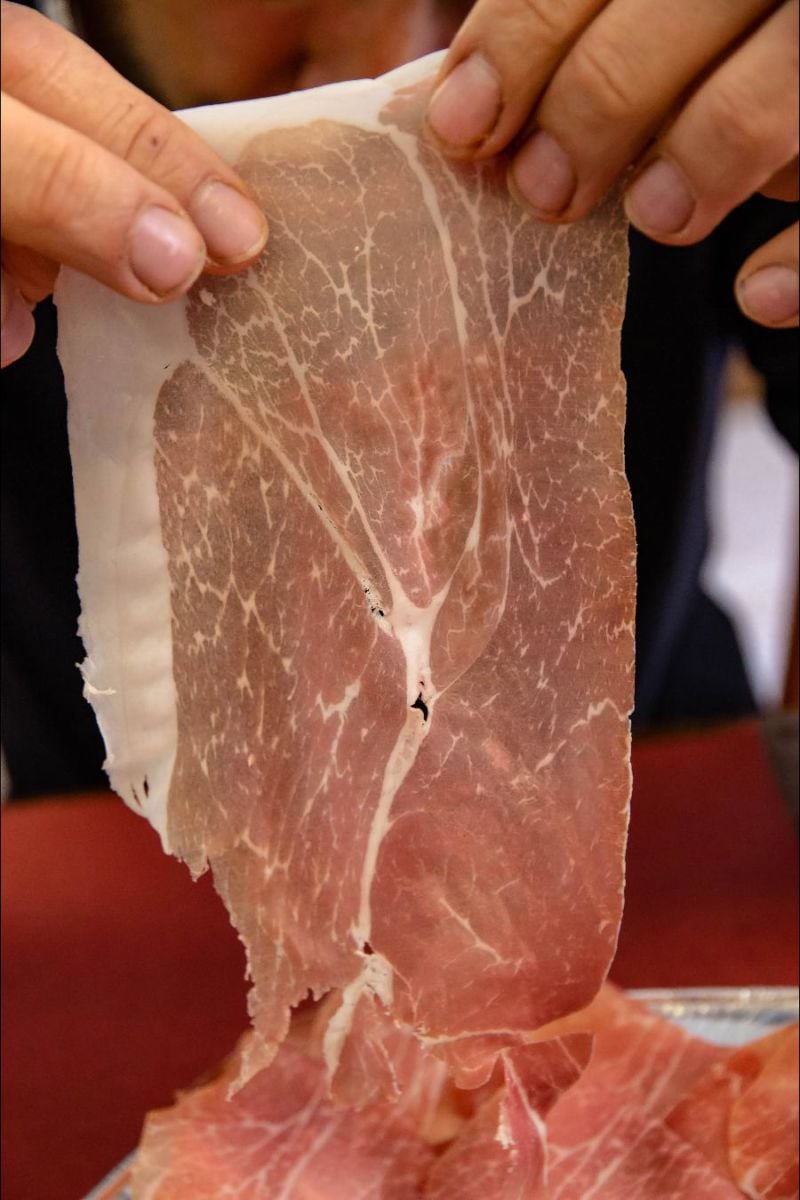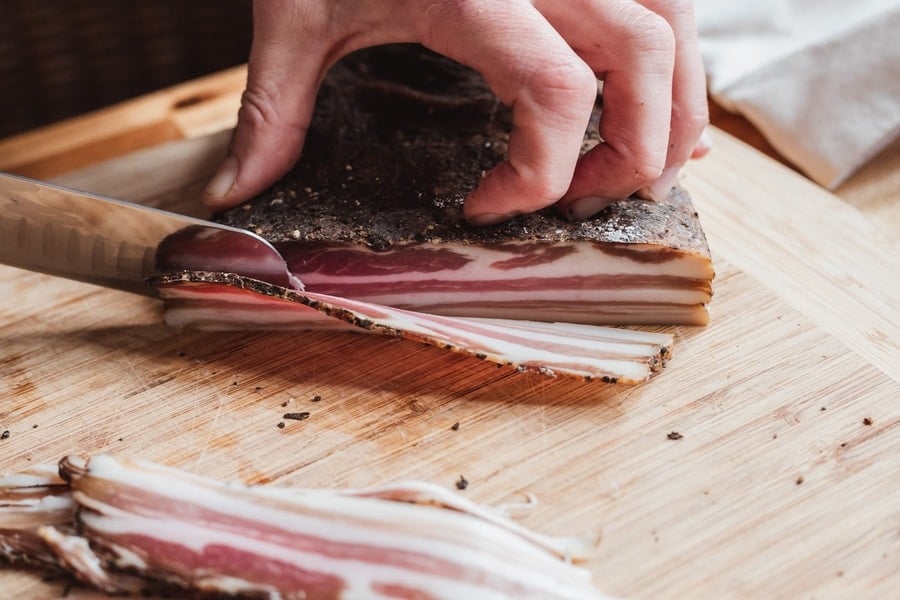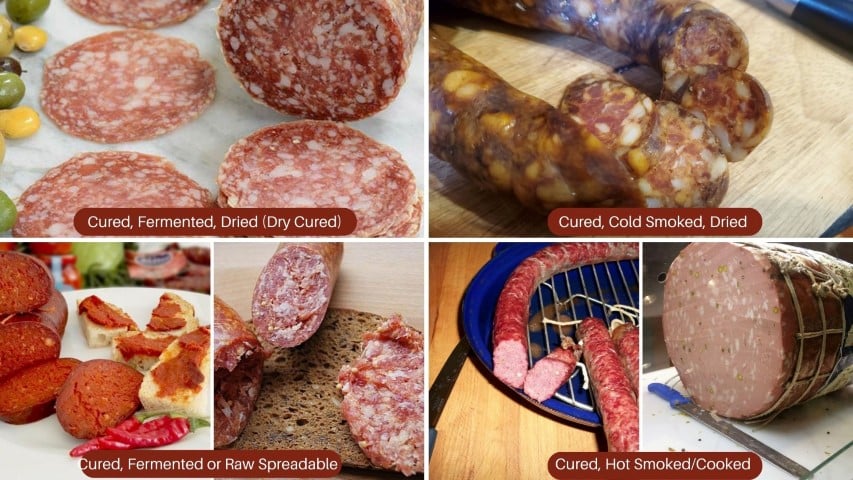Certain cured meats are classic, and others are highly recommended if you are preparing a classic antipasto platter.
When constructing a classic antipasto platter, you will want to use cured meats, including the classic salumi of Italy, such as Prosciutto/Parma Ham, Pancetta, Dry-Cured Salami, Coppa, and Bresaola.
You might consider constructing an antipasto platter when preparing dinner or an appetizer for your next social gathering or family meal.
Key Points:
- Flavor and Presentation: These meats offer a variety of flavors, textures, and visual appeal, enhancing the overall presentation of the platter.
- Unique Characteristics: Each cured meat has unique qualities, such as the sweetness of Parma Ham, the marbling of Pancetta, the variety of flavors in Dry-Cured Salami, the lean richness of Coppa, and the boldness of Bresaola.
- Culinary Exploration: While creativity is encouraged, sticking to these classic options ensures an authentic and satisfying antipasto experience for any social gathering or family meal.
This Italian creation is incomplete without delicious cured meats, but which ones belong on it?
While you can choose many different varieties of cured meat (history of cured meats) for an antipasto platter, these are the best options to keep it traditional, classic, and straightforward.
And a charcuterie platter for me isn’t the real deal without some of these whole muscle cured meats!
Of course, you can use your own creativity to enhance a more modern antipasto platter, but if you are looking for the best and most classic options, then these will be your best bet. Read on to take a closer look at what these meats will bring to your table.
List of Cured Meat for an Antipasto Platter
Prosciutto/Parma Ham

In Parma – the sweetest cured meat I have had (24 months this one was dried for)
Prosciutto and Parma ham are perhaps two of the most popular meats to include on a classic antipasto platter.
While many people assume that these are the same (considering Parma ham is actually called prosciutto di Parma), the two meat varieties each bring a unique flavor to the table, prompting immediate inclusion of both types of meat on your platter.
And there are other subtle variations across Italy of ‘Prosciutto”.
Prosciutto is dry-cured meat- ham in particular- that can be eaten without being cooked. Thus, it makes a straightforward snack to place on your plate.
It is as delicious as it is beautiful, and its darker coloration attracts the taste buds.
However, what most people call prosciutto is more traditionally called prosciutto di San Daniele. Since it is more common, it is cut off to be referred to as prosciutto (here are some prosciutto substitutes I wrote about).
It is, in fact, an Italian-based ham that is delightful on any antipasto (Italian) cured meat platter.
Conversely, Parma ham is more technically called prosciutto di Parma, as it is a dry-cured pork-based meat from the city of Parma, Italy.
It is a high-quality meat that earns a top spot on any antipasto platter.
This DOP cured meat is delightful for its flavor alone or paired (some wine pairing ideas I wrote about) with cheeses and bread on your platter. Compared to what is known as just prosciutto, it has a bit more of a sweet taste and has a richness that is incomparable with other dry-cured meats.
This is because it is air-dried in Emilia-Romagna during its curation process – this cured meat is perfect for your antipasto platter.
It’s salt and pork – but also the craft, the river valley air, and the quality of the pig, which is strictly adhered to and fed some of the way from the Parma cheese production.
While eating your meal, you can explain to your friends and family members why you are confident that this DOP-cured meat is authentic.
However, your friends will not need convincing that Prosciutto or Parma ham both belong on a classic antipasto platter – it’s the alpha-cured meat. Trust me, I know cured meats!
I created a website all about this glorious craft.
Pancetta

Pancetta is another beautifully seasoned and prepared cured meat perfect for a classic antipasto platter.
While it is often mistaken for prosciutto because of its comparable visual appeal, it comes from the pork belly. It is rendered in deliciously marbled fat throughout its thinly sliced (or cubed) presentation.
Pancetta is often wrapped around small vegetables and roasted, but you can also eat it alongside another item on your antipasto platter. For example, you could pair it with a delicious pepper or other cooked or raw vegetable that will bring out its flavor.
This meat, in particular, has a tasty blend of seasonings used in its preparation so that you can appreciate all of the natural ingredients and spices.
Depending on your recipe, these may include juniper berries, salt, pepper, bay leaves, nutmeg, and thyme.
This means you can recognize how this flavor would add quite a nice presence when consumed standing alone, but it can also add a richness and depth to your meal when you pair it well with other foods.
So, when looking for cured meat to place on your classic antipasto platter, pancetta is one you will not want to skip out on.
Dry Cured Salami

Dry-cured salami is another cured meat that will make the perfect addition to your antipasto platter.
One unique quality about this meat compared to the above-mentioned meats is that it is sliced in links rather than thinly sliced, which can add a bit of variety to the shape and presentation of your platter.
While this might seem trivial to some, the presentation of the antipasto platter is a large part of its appeal.
As we all know, we eat with our eyes.
If the same meats were thrown on a plate together and not presented as delicately, it could even seem strange to eat an entire course of protein and other snacks.
Regardless, dry-cured salami is a fan favorite for a classic antipasto platter because it can come in so many different flavor varieties.
Depending on the region and cultural influence of where this salami was made, different recipes (and spices) will alter how this meat tastes.
With that, you can rest assured that your antipasto platter will have plenty of variety, and you will be able to come up with a unique set of meat that is delightful for snacking or for your main course.
If you are looking for a few recommendations, begin with dry-cured salami with a nice garlic flavor. This added flavor can pair well with just about any other item on your antipasto platter.
Coppa

Coppa (or capocollo) adds another point of interest to any antipasto platter.
Particularly, since this dry-cured meat option comes from the neck and shoulder of the pig, it will be much leaner and have less fat marbling throughout.
This enhances its deep red coloration and also adds richness to its flavor, considering you are consuming more meat than fat.
Compared to other types of cured meat, coppa is unique in the way that it is prepared. Instead of being ground up (like salami) and cured in this way, coppa is a whole cut of meat that is seasoned and prepared without being ground up. (Whole muscle dry-cured meats, this site shares many of my learnings over 15 years about this – I wrote a helpful post about trying it at home here.)
Typically, the seasonings are added after the meat has had a chance to dry cure (several weeks to months, depending on the recipe and cut of meat).
Because of its rich flavor, it can complement many different items on your antipasto platter, including savory cheeses and olives, if those are your favorites.
Most people find that when this meat is thinly sliced, it has a flavor that will pique your interest as it is often seasoned with a hefty amount of pepper (and some people even add hot peppers to create a more spicy variety).
Also, since this is one of the more expensive types of dry cured meats, you are sure to wow your guests with the flavor they might not have experienced on other antipasto platters.
You are definitely going to want to include this cured meat on your classic antipasto platter.
Bresaola
Finally, bresaola is another beautiful example of a cured meat option for your classic antipasto platter.
Unlike the other options on this list, bresaola is a dry-cured beef, so it will add a unique flavor to your antipasto platter compared to the other options that are included.
I make braesola-style whole muscle cured meat with Venison, Himalayan Tahr, Beef, and wild Cattle Beast Beef!
Plus, this dry-cured meat is a favorite, although many people do not realize just how delicious it can be.
Because it is beef, it will be much darker in color than the other meat options you might have chosen to include, but this can benefit the presentation (and flavor profile) immensely.
This dry-cured meat is often prepared with a salt cure, pepper, and juniper berries.
When added to an antipasto platter, bresaola is sure to be one of the top choices for most of your friends and family at your dinner party.
Since it has such a unique appearance and a bold flavor, you can pair it with classics like cheese and bread, or you can encourage your guests (as well as yourself) to eat this one instead of the other options on your platter.
Braesola should have no visual fat, and it’s pure protein.
If you are interested in the culinary exploration of antipasto and antipasti (and the misspelling – antipasti) – I wrote about it in detail here.

Tom Mueller
For decades, immersed in studying, working, learning, and teaching the craft of meat curing, sharing the passion and showcasing the world of charcuterie and smoked meat. Read More
